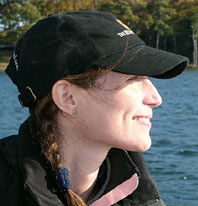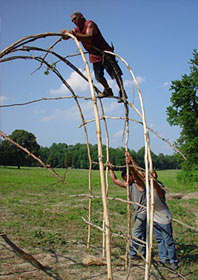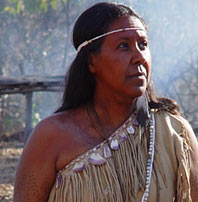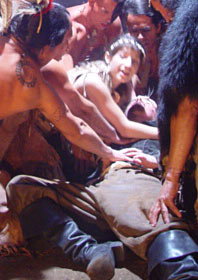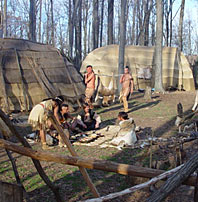The Producer's Story:
Recreating Pocahontas's Village
by Lisa Quijano Wolfinger
Shooting historical
dramatizations can be a bit like running a three-ring circus. It is a whirlwind
of activity and problem solving: shooting one scene while setting up the next,
rearranging schedules because of rain or a missing actor, making compromises
when a prop breaks or a weapon misfires. If you are lucky you avoid the
snarling lions and disgruntled clowns and keep the whole enterprise going until
you run out of time and/or money. The important thing is to keep the whip handy
at all times. This experience was no different.
The process started
months in advance with careful study of the historical records to glean every
last detail that would ensure absolute authenticity. Accuracy in historical
reenactments is vital, especially for a NOVA. Everything from facial hair to
types of weapons to how to hold a spoon becomes of crucial importance. In this
case we had the added challenge of recreating an entire Indian settlement about
which very little is known: Werowocomoco, home to the legendary Pocahontas and
her powerful father, Powhatan.
It gets a little
tough to direct a scene when you are trying to avoid smoke inhalation.
The Jamestown Living History Museum in
Virginia has a few historically accurate longhouses on its property, but the
museum would only allow us to shoot there after hours, after the tourists left.
That really wouldn't work for us because we had quite a few daylight
scenes to shoot. After scouting and rejecting various possibilities, my line
producer Buck Woodard (an anthropology Ph.D. student and advisor on Terrence
Malick's feature film about Pocahontas, "The New World") came
up with a brilliant plan.
It takes a village
Henricus Park is a modest living museum
an hour outside of Richmond, Virginia. It represents the settlement founded in 1611 by Sir Thomas Dale, second only to Jamestown as the
oldest English settlement in Virginia. Even more fitting, the actual Henricus
was near where Pocahontas grew up among the Appomattox tribe. It is also
where the English later imprisoned her, and where she eventually converted to
Christianity and married John Rolfe in 1614.
The Park consisted of an English section
with a few period wattle-and-daub houses (structures made with woven branches
covered in mud or clay) and a very humble Indian village (if you can call two
moldy longhouses and an old drying rack a village). None of it was ideal for
us, but it did have the advantage that both English and Indian sets would be
side by side, a huge cost savings for this kind of shoot. This is where
Buck's brilliant plan came into play: he suggested that NOVA offer to
bring in a team of skilled Virginia Indians to refurbish the village in
exchange for the park letting us shoot there for free. The folks at Henricus
were thrilled. They had been trying to attract the participation of Virginia
Indians for years without success. For them, this was a dream come true.
So Buck and his team set to work. While
they transformed the two moldy longhouses into a very credible village in the
space of a month, we embarked on the next task: hiring a cast. Paula Apsell,
NOVA's executive producer, had come up with the provocative idea of
asking the Virginia Indians to play their ancestors. Intertribal politics in
Virginia is complicated and often messy, so the prospect was daunting. Yet
again, Buck came to the rescue by diplomatically convincing a group of
volunteers to participate.
The cast included members of a variety of
tribes that once were part of Pocahontas's father's domain. I was
told beforehand that it would be quite an accomplishment to have such a mix of
tribes in a confined space without at least one argument. (Apparently Chief Powhatan himself was
the last to accomplish such a feat.) But I have rarely worked with such a
friendly and cheerful crowd. Best of all, Ashlee Harless, the young girl who
was to play the 11-year-old Pocahontas, was actually the granddaughter of a
Rappahannock Chief. You could say she was born to play the role.
Wardrobe malfunction
So we had our actors but no costumes.
Unfortunately, all the beautiful costumes created for "The New
World" had been ditched in a dumpster on a Hollywood backlot by mistake,
so we had no choice but to make our own. It's amazing what arcane
knowledge you pick up doing these projects. It turns out that making authentic
17th-century Woodland Indian garb is not as simple as buying some
deer hides and sewing them together. Untanned deer hides are very white, and
the store-bought variety are stained an unnatural shade of orange. Either way
the end result looks like a cheap Halloween costume.
The secret, apparently, is something
called "brain tan," a tan literally made from the brain and tallow
(fat) of animals. It is something the Indians did to their deer hides for
centuries but isn't done much anymore. (I can't imagine why.) Now,
my talented and long-suffering costume designer, Andrew Poleszak, will always
go the extra mile for me, but boiling animal brains was pushing it. In the end
he avoided the issue by using ready-dyed animal skins that looked the right
color, and we hired an army of seamstresses to get the costumes done in time.
We all thought the problem was solved.
In the end, our shoot went off well enough. And all without a single crack of the whip.
The disaster—because there always
has to be a disaster—was evident when we arrived on location and saw the
pre-dyed deer skin clothes on hangers ready for fittings. They weren't
orange, but they weren't right either. Not only did the clothes have to
be the right color, they also had to look lived in. These were neither. Andrew
likes to share his angst with those around him, but he always comes up with a
solution. In this case it took 24 hours of experimenting with leather dyes,
sponges, rags, and spray guns to get the clothes looking right. The grass and
walls outside the wardrobe department looked as though some over-enthusiastic
paintballers had used it for target practice.
Once Andrew found a method that worked,
it took him and four other tireless wardrobe crew and seamstresses another 24
hours to get the right look. Needless to say the final product was entirely
believable. No one would ever know that these clothes were not properly brain
tanned and lived in for years while their owners worked in the cornfields, fished, and
cooked. Other than being a little damp from the dye, the costumes the actors
wore on set looked every bit as good as those made by Terrence Malick's
team with a lot more money and time.
Speaking a forgotten language
With only four days to shoot, we worked
hard and fast. The trickiest scene to shoot by far was the scene in the
longhouse when Pocahontas allegedly saves Smith from execution. With a real
fire going, the longhouse became very smoky very fast. It was even worse when
we were forced to close the smoke holes to better control the light. Several
times I was forced to run outside gasping for air. The trick, apparently, is
staying close to the ground, but it gets a little tough to direct a scene when
you are lying prostrate trying to avoid smoke inhalation.
Another challenge was having our actors
deliver lines in the Algonquian language. Though it has been extinct for more
than 200 years, linguists have been hard at work trying to reconstruct it. The
process of reviving a dead language is a fascinating piece of detective work.
The first step is reconceptualizing the dialogue in American Indian terms. For
example, a member of Powhatan's tribe wouldn't think of the Jamestown settlers
as coming from a "land to the east," since, for all they knew, there
was only water to the east. So a reference to England was rephrased as the
"island on the other side of the water."
Then experts have to figure out how the
dialogue would be spoken in Virginia Algonquian. The only surviving vocabulary
is a list of about 50 words set down by Smith himself, plus a 600-word list
recorded in 1612 by William Strachey, a secretary for the Jamestown colony. The
list is a crucial resource for modern linguists and also provides a rough guide
to pronunciation.
The next step is to compare every word to
better-documented Algonquian languages, including the ancestral
Proto-Algonquian that linguists have reconstructed through cross-language
comparisons. This painstaking work allowed us to write dialogue for our
Powhatan and Pocahontas. Robert Green (Powhatan) and Ashlee (Pocahontas) spent
much time with our on-set advisors preparing and practicing the correct
pronunciations and inflections. Ashlee especially did a terrific job
remembering some very tough lines and delivering them with spontaneity.
In the end, the three-ring circus that
was our shoot for "Pocahontas Revealed" went off well enough. And
all without a single crack of the whip.

